My Journey to Guyana: Village Life
By Kylie Purdy
 ( Earlier this year Trussville native Kylie Purdy spent several days in Guyana and Brazil as part of an immersion program through Spring Hill College in Mobile. Kylie, who also is a team member in our Mobile store, shared some of her experiences.)
( Earlier this year Trussville native Kylie Purdy spent several days in Guyana and Brazil as part of an immersion program through Spring Hill College in Mobile. Kylie, who also is a team member in our Mobile store, shared some of her experiences.)
The sound of roosters and the bustling breeze on my mosquito net woke me up around 5:30 a.m. We gathered under the benab (a palm-thatched shelter) for breakfast and ate an assortment of watermelon, toast with jam, and fresh juice.
Shortly after breakfast, we departed for Nappi village where we would be spending our week. The 35-minute drive took us through open savannah and rolling valleys, primarily on dirt roads. A few solitary homes dotted the landscape. The environment here was already the polar opposite of what we experience in our lives.
When we arrived at the village, we went to sit under the mango tree, which appeared to be one of the main gathering sites for the villagers. They welcomed us with open arms and shared some of their native songs and history with us.
Only about 20 villagers greeted us, but it became clearer throughout the day that far more live there. In fact, they told us about 1,200 people live in Nappi Village.
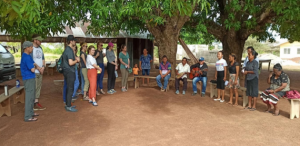
Village gets few visitors
Guyana is home to nine Amerindian nations. Nappi Village is represented by the Makushi nation. When we first learned about this village, I envisioned the homes very close together in a small village. However, as we began our walking tour of the village, I realized this village is miles upon miles.
Our first stop included their governmental and legislative building. It was a small, open room housed in a white brick structure. We found a welcome book for all the visitors to sign and many maps of the area. I noticed the book contained only a few signatures from visitors in 2003. Not many people make the journey to this village.
Thanks to the maps, I realized the village is separated into zones. One zone is dedicated entirely to sustainable farming and utilization. This meant that they were very aware of the need to look for more natural and greenways to produce their crops and materials that would not cause more harm to their local environment. Other zones included livestock rearing, homesteads, and tourism.
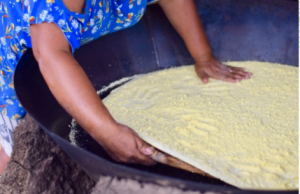
Walking tour and cassava
We left the government building and made our way through the rolling hills to our first stop where we watched villagers make cassava being made. Cassava, which comes from a root of a tropical tree, requires careful preparation to get rid of any traces of the poisonous component, cyanide.
It became apparent at only our first stop of our walking tour that the people truly sustain themselves off the land. What was also noticeable that the younger girls of the family were the primary ones cooking and preparing the cassava.

We also stopped at a woman’s house who specializes in cotton weaving. She explained that she uses the cotton to make hammocks where the kids sleep. She also makes traditional clothing.
We later stopped at a mango tree where we ate mangos and tried sweet limes, which were delicious. We trekked on with sticky fingers and happy hearts.
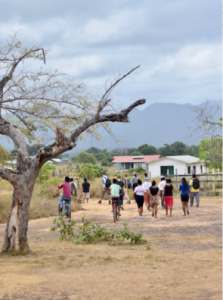
Walking with villagers
Throughout our entire two- to three-mile walk, the villagers traveled alongside us. They welcomed us with eager minds, ready to share how special their village and traditions were to them. I
talked with one woman named Bernadette who told me she had nine children, but none of them live in the village anymore. Many children leave for Brazil or Georgetown in search of jobs, usually in mining.
Another issue for the village: the decreasing interest in culture and preservation of the village. Many of the children aren’t showing as much interest in farming and cultivating the land, and the native language and dances are not being taught in schools. It was heartbreaking to hear.
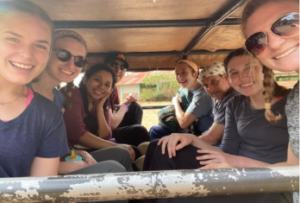
After lunch, we left for St. Ignatius. In the afternoon, we drove over the border of Brazil for ice cream. It’s weird to be that close to another country and be able to drive over another country’s border within five minutes. Following a packed day, we retreated to our quaint guest house and relaxed for the evening.
Let us help you prepare for your next adventure! Alabama Outdoors wants everyone to enjoy the outdoors, and we work to build loyalty one connection at a time. Visit one of our stores or take advantage of our shipping or curbside pickup! #BeOutdoors